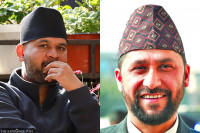Politics
Nepali Congress-led alliance likely to form governments in all seven provinces
UML leads FPTP tally in 3 provinces, Congress ahead in 4.
Nishan Khatiwada
Just as in the case of federal parliament, the post-poll positioning of political parties is coming into focus in the provincial assemblies too.
The shape and size of the federal government will have a big impact on government-formation in provinces. If the ruling Congress-led alliance gets a majority in the federal parliament, and forms a government at the central level, the alliance members are likely to agree to a package deal including the provinces, say political watchers.
The leaders of the Congress-led alliance have also started claiming that the five-party alliance will make the federal government. Speaking after a meeting of the coalition in Bhairahawa on Sunday, Nepali Congress leader and Home Minister Bal Krishna Khand said, "The five-party alliance will form the government and the coalition will last for the next five years."
On Saturday, Maoist Centre chair Pushpa Kamal Dahal and Nepali Congress chief Sher Bahadur Deuba had met at Baluwatar to discuss the alliance's next step. In the meeting, they had agreed to give continuity to the coalition.
If that is the case, and given the election results so far, there is a high chance of the Congress-led alliance forming governments in all seven provinces.
At the time of this writing, the CPN-UML is leading the first-past-the-post (FPTP) seat tally in three provinces while the Nepali Congress is ahead in four. Under the proportional representation (PR) elections in provinces, the Congress is ahead in Madhesh, while the UML tops the list in all other provinces.
The newly formed Rastriya Swatantra Party, which has performed well in the federal polls, did not contest the provincial seats.
The UML has thus far won 23 provincial seats under the first-past-the-post electoral system in Province 1. Similarly, the Congress has 14 seats, while the Maoist Centre is third with nine seats. The Rastriya Prajatantra Party has two seats and the CPN (Unified Socialist) too has bagged a pair of seats.
Of the six provincial constituencies in which counting is underway, the UML is leading in one, Congres in four and the Unified Socialist is leading in one.
Province 1 assembly is 93-strong, where 56 members are elected from the FPTP system while 37 come from the proportional representation category. And the Congress-led alliance seems to be in a position to form the next government.
Under the proportional representation system, the UML is leading the count in Province 1 with 489,894 PR votes, ahead of the Congress, which has 418,372 votes. The Rastriya Prajatantra Party has 148,759 votes and the Maoist Centre has 144,187. The Janata Samajbadi Party is in third place with 49,412 PR votes, while the Unified Socialist stands fifth with 44,674 votes.
The UML had won 14 provincial seats as of Sunday evening in the Madhesh provincial assembly. Similarly, Nepali Congress had 13 seats, while the Janata Samajbadi Party was placed third with eight seats. Loktantrik Samajbadi Party had locked in seven seats while the Janamat Party and independent candidates got six seats each. The Maoist Centre and the Unified Socialist won four seats each.
The UML is leading in one Madhesh provincial seat, where the counting was still underway on Sunday evening. The Congress-led alliance has bagged more seats than the coalition led by the UML in the province. The Madhesh provincial assembly is 107-strong where 64 members are directly elected and 43 are elected under the proportional representation system.
In the Madhesh provincial assembly, Nepali Congress is at the top of the PR table with 287,516 votes, while CPN-UML and Janata Samajbadi Party stand second and third with 245,510 and 193,523 votes, respectively. The Janamat Party led by CK Raut has got 172,317 votes, the Maoist Centre 112,381 votes, the Unified Socialist 83,853 votes and the Loktantrik Samajbadi Party has received 67,823 votes so far.
In the Bagmati provincial assembly, the Congress is leading the tally with 24 seats, trailing the Maoist Centre, which has 14 seats. Similarly, the UML is third, winning 12 seats. The Rastriya Prajatantra Party has won seven seats while the Unified Socialist has locked in five provincial seats. The Hamro Nepali Party and the Nepal Majdoor Kisan Party have won a seat each.
Counting for the two provincial seats in Dolakha district has been halted for the time being. The Congress-led alliance is in a comfortable position under the direct election system in the province. The Bagmati province has a 110-member legislature—66 members elected from the FPTP and 44 from the proportional representation category.
The UML has received 386,273 votes under the PR category in the Bagmati provincial polls, while the Congress has got 335,650 votes. The Rastriya Prajatantra Party stands third with 195,108 votes. The Maoist Centre is in fourth place, having received 193,201 votes and the Nepal Majdoor Kisan Party has got 61,245. Meanwhile, the Unified Socialist has garnered 38,357 votes.
In the Gandaki provincial assembly, the Congress is leading the race with 16 seats while the UML is trailing with 12 seats. The Maoist Centre is in third place with five seats, while an independent candidate has won a seat. Gandaki has 60 members where 36 are elected under the FPTP system and the rest through the proportional representation system. Counting is yet to start in two provincial constituencies in Gandaki. The Congress-led alliance is in a comfortable position to form a government, if the results so far are any guide.
The UML is leading the PR vote tally for Gandaki provincial assembly with 340,533 votes, followed by the Congress with 317,596 votes. Similarly, the Maoist Centre has received 115,366 votes, while the Rastriya Prajatantra Party is in fourth place with 57,053 votes.
Similarly, in the Lumbini provincial assembly elections, UML is in first place, winning 18 seats. Congress is trailing the UML with 16 seats, while the Maoist Centre stands third with four seats. The Janata Samajbadi Party, the Nagarik Unmukti Party, the Loktantrik Samajbadi Party and the Rastriya Prajatantra Party have locked in two seats each. The Janamat Party got one seat and independent candidates have won three seats.
The Congress and the Maoist Centre are leading in one provincial constituency each where vote counting is underway. The competition is tough between the Congress-led alliance and the UML. As many as 52 assembly members will be directly elected for the Lumbini provincial assembly, while 35 will get elected under the proportional representation category.
The UML tops the list with 502,325 votes, and the Congress is in second place, having received 441,659 votes under the proportional representation category in the elections for the Lumbini provincial assembly. Meanwhile, the Maoist Centre stands third with 174,590 votes. The Rastriya Prajatantra Party has so far received 113,419 and the Nagarik Unmukti Party 89,809 PR votes for the provincial assembly.
Likewise, the Congress and the Maoist Centre have won nine seats each for the Karnali provincial assembly. UML has so far got five provincial seats while an independent candidate has won one seat. The UML did not fare well in the province under the FPTP system. As such, the Congress-led alliance has a majority to form a government.
The Karnali provincial assembly is 40-strong where 24 members are elected under the FPTP system and 16 under the proportional representation category.
In the Karnali assembly, the UML has 183,950 PR votes and the Congress has 170,756 votes. The Maoist Centre is standing third with 137,629 votes. Meanwhile, the Unified Socialist is in fourth place with 35,826, trailing the Rastriya Prajatantra Party, which has received 25,186 votes.
In the Sudurpaschim province, the Nepali Congress tops the table with 11 seats for the provincial assembly, and trailing is the Maoist Centre with eight seats. The Nagarik Unmukti Party has so far won five seats, while the UML has three seats. The Unified Socialist has locked in one seat while an independent candidate has won one seat and is leading in one.
Counting in two provincial seats is yet to begin in the province. The UML had a disappointing result under the FPTP system for the Sudurpaschim provincial assembly with the Congress-led alliance in advantage. The Sudurpaschim provincial assembly has 32 directly elected seats and 21 proportional representation seats.
However, the UML is leading the PR vote count for the provincial assembly with 240,482 votes. Nepali Congress, with 226,369 votes is in the second position. The Maoist Centre stands third with 108,296 PR votes, while the Nagarik Unmukti Party is in fourth place, having received 60,036 votes. The Unified Socialist has received 39,779 votes.




 6.12°C Kathmandu
6.12°C Kathmandu

.jpg&w=200&height=120)












